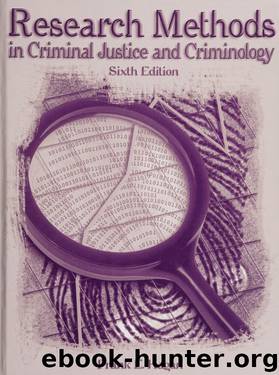Research methods in criminal justice and criminology by Hagan Frank E

Author:Hagan, Frank E [Hagan, Frank E]
Language: eng
Format: epub
Tags: Criminology -- Research -- Methodology, Criminal justice, Administration of -- Research -- Methodology, Criminal statistics, Criminologie -- Recherche -- Méthodologie, Justice pénale -- Administration -- Recherche -- Méthodologie -- Méthodes statistiques, Criminologie, Criminalité -- Recherche -- Méthodologie, Strafrechtspleging, Onderzoeksmethoden, Criminologie -- Recherche -- Methodologie, Justice penale -- Administration -- Recherche -- Methodologie -- Methodes statistiques, Criminalite -- Recherche -- Methodologie
ISBN: 9780205366774
Publisher: Boston, MA : Allyn and Bacon
Published: 2003-05-06T19:00:00+00:00
USE OF AVAILABLE DATA AND ARCHIVES
The National Institute of Justice (NIJ) was the pioneer among federal agencies in requiring that data sets from funded research be given to the agency upon completion of the project. In 1985 the National Academy of Sciences described this
Secondary
analysis
Primary data sources
Secondary data sources
policy as "remarkable and a model for other research funding agencies," and in 1986 the National Science Foundation adopted a data resource policy similar to the NIJ policy that had been in existence since 1979.
Secondary Analysis
Secondary analysis, or the reanalysis of data that were originally gathered or compiled for other purposes, is an excellent economizer of researcher time in data gathering, nonreactive, and a resourceful use of the mountains of data generated in modern society (see Hyman, 1972; D. Stewart, 1984). Reanalysis of historical records, precinct and court records, and such documents as the Uniform Crime Reports (UCR), given certain recognized limitations, can make excellent use of data that, although gathered for other purposes, can be used to address research concerns in criminology and criminal justice.
Many second-hand stores have names like "Trash 'n Treasures," referring to the phenomenon that one person's hash is another's treasure. Our industrial society has generated so much material to be discarded that our trash sites are nearly filled to capacity. Similarly, our current postindustrial society generates information and data at considerable expense that, once they serve agency or organizational purposes, are often confined to the equivalent of a trash dump site. Some of these data consist of both primary data sources, which refer to raw data unaccompanied by any analysis or interpretation, and secondary data sources, which consist of analyses, syntheses, and evaluations of the information (Lutzker and Ferrall, 1986). Thus, the UCR itself would constitute a primary data source, whereas an existing research study that used the UCR and other sources to predict crime trends would be a secondary source. Such available data, consisting of both primary and secondary sources, represent a "gold mine" of information waiting to be exploited. Primary records such as letters, diaries, and memoirs may provide insight into events or research issues long after they have occurred (Gottschalk, Kluckhohn, and Angell, 1945).
Personal Documents and Biographies
The use of personal documents in social research was pioneered by Thomas and Znaniecki in their classic sociological work The Polish Peasant in Europe and America (Thomas and Znaniecki, 1918). They made particularly good use of diaries and personal letters to provide in-depth, personal views of their subjects.
Diaries kept by subjects have also been used as a source of information on drug subcultures (Zimmerman and Wieder, 1974). In the latter, individuals may keep intimate journals, memoirs, and logs (Denzin, 1989). The diary method involves investigators commissioning individuals to maintain a record of activities for a specified period of time (Courtright, 1995). In addition to combatting memory decay, respondents are better able to reflect on their performances and have greater flexibility in recording events and their meaning than in a standard retrospective interview. This technique has been used to measure
Download
This site does not store any files on its server. We only index and link to content provided by other sites. Please contact the content providers to delete copyright contents if any and email us, we'll remove relevant links or contents immediately.
Cecilia; Or, Memoirs of an Heiress — Volume 1 by Fanny Burney(32434)
Cecilia; Or, Memoirs of an Heiress — Volume 2 by Fanny Burney(31868)
Cecilia; Or, Memoirs of an Heiress — Volume 3 by Fanny Burney(31852)
The Great Music City by Andrea Baker(31327)
We're Going to Need More Wine by Gabrielle Union(18967)
All the Missing Girls by Megan Miranda(15561)
Pimp by Iceberg Slim(14378)
Bombshells: Glamour Girls of a Lifetime by Sullivan Steve(13972)
Talking to Strangers by Malcolm Gladwell(13220)
Norse Mythology by Gaiman Neil(13204)
Fifty Shades Freed by E L James(13157)
For the Love of Europe by Rick Steves(12922)
Mindhunter: Inside the FBI's Elite Serial Crime Unit by John E. Douglas & Mark Olshaker(9186)
Crazy Rich Asians by Kevin Kwan(9166)
The Lost Art of Listening by Michael P. Nichols(7403)
Enlightenment Now: The Case for Reason, Science, Humanism, and Progress by Steven Pinker(7228)
The Four Agreements by Don Miguel Ruiz(6620)
Bad Blood by John Carreyrou(6543)
Weapons of Math Destruction by Cathy O'Neil(6139)
